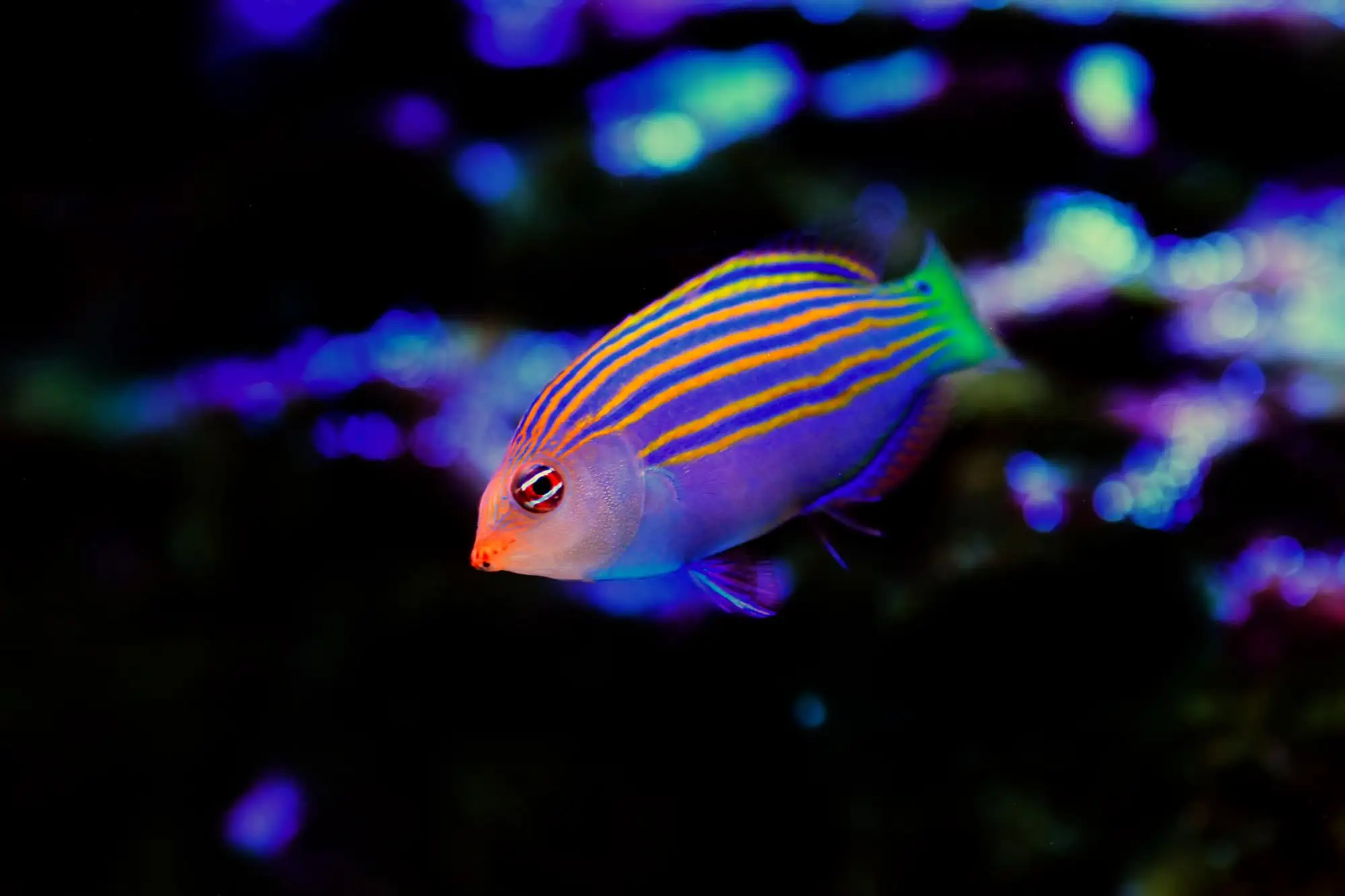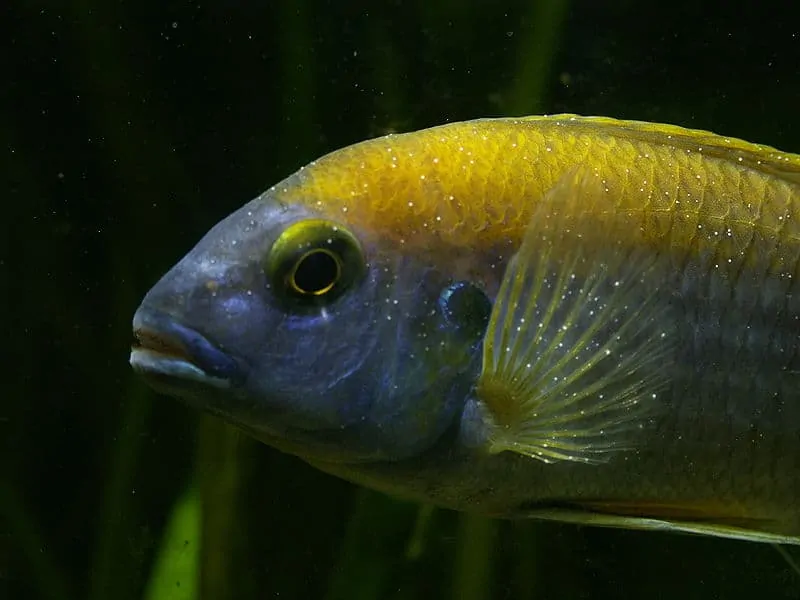The Six-line wrasse makes a bright and beautiful addition to any large saltwater fish tank setup.
Although they can be aggressive towards some smaller fish and invertebrates, once they’re established, these vibrantly colored fish are relatively easy to care for and are regarded as reef-safe.
This guide explains how to care for the stunning Six-line wrasse, so you can make an informed decision on whether one of these marine beauties would be a good fit for your marine tank.
Six-Line Wrasse – At A Glance
| Six-Line Wrasse Info | |
|---|---|
| Scientific Name | Pseudocheilinus hexataenia |
| Common Name (species) | Six-line wrasse, Six Bar wrasse, Six Stripe wrasse |
| Family | Labridae |
| Origin | Indo-Pacific, including Fiji |
| Diet | Carnivore |
| Care Level | Easy |
| Activity | Active |
| Lifespan | 4 to 6 years |
| Temperament | Semi-aggressive |
| Tank Level | Mid to bottom of the water column |
| Minimum Tank Size | 30 gallon |
| Temperature Range | 75 to 82 F (24 to 28 C) |
| Water Hardness | 8 to 12 dKH |
| pH Range | 8.1 to 8.4 |
| Water type | Saltwater |
| Breeding | Cannot be bred in captivity |
| Compatibility | Aggressive toward invertebrates and small fish but considered to be reef-safe and won’t harm corals and sponges |
Origins
Most of the Six-line wrasse that you see for sale in the aquarium hobby are live-caught specimens taken from the Indo-Pacific, especially the coast of Fiji.
These beautiful fish are found in shallow, clear, warm waters on coral reefs, spending their time foraging for the small prey animals they eat in rocky crevices and cracks.
Appearance
As you might expect from the fish’s common name, It has six contrasting brilliant red and orange lines running horizontally along its blue-to-pink body. The fish’s tail is green to yellow and has a false eye spot on the dorsal tail peduncle, which is used to fool predators into attacking the fish’s rear end so it can escape more easily.
There is no external difference in appearance between male and female fish, although many fish keepers have noticed that the male fish’s body colors become brighter when they come into spawning condition.
Size
The six-line wrasse is a quite small fish that grows to only three inches long, making it a good choice for a modestly-sized marine aquarium.
Life Expectancy
These fish have a relatively short life expectancy of between four and six years. However, their lifespan can be extended if they’re fed a high-quality, nutritious diet and provided with optimum living conditions.
Activity Level
Once you have the established in your aquarium, Six-line wrasse is pretty straightforward to care for and amuse themselves during the day by foraging between crevices and cracks in live rock and the substrate. Although these fish are semi-aggressive, they generally keep to themselves if you provide them with an enriched environment to live in with lots of places to explore.
As an added bonus, these fish are known to prey on urchins, flatworms, and nuisance snails, helping to keep your tank environment free from pests.
We recommend that you don’t keep too many “cleaner” fish in a tank with a six-line wrasse to prevent fighting that could result in injury or even death.
Compatibility and Tank Mates
The six-stripe wrasse is widely regarded as reef-safe and doesn’t nip at sponges or corals. However, these fish are known to prey on snails, crustaceans, and clams, and they can be aggressive towards other fish, especially smaller, peaceful species.
Since these are aggressive fish, it’s best to introduce them to an established tank once all the other fish have had the chance to settle in. Plenty of space is also recommended to prevent squabbling over food, territories, and other resources.
Be sure you allow plenty of room for all your livestock and distribute the food around the tank to reduce competition.
As with many aggressive fish species, we recommend keeping just one six-line wrasse in your tank to keep aggression to a minimum unless you’re planning a breeding program.
You can usually keep some of the bigger, semi-aggressive species of wrasse, like Dragon and Banana wrasse, relatively safely with the Six-line wrasse. However, bear in mind that you will need to allow the fish plenty of space, as they do grow quite large and can be somewhat belligerent.
Feeding
As with all fish species, your wrasse will thrive if fed a high-quality, varied, balanced diet.
What to Feed Your Six-Line Wrasse
These fish are primarily carnivorous, feeding on mostly animal proteins, including small invertebrates. They also nibble at flatworms and urchins, which can be quite helpful in ridding your tank of these pests.
We recommend feeding the Six-line wrasse a diet of carnivorous pellets supplemented with meaty treats, including brine shrimp, mysis, and other frozen carnivore foods. Adding vitamins to the food is also beneficial to ensure the fish receive all the nutrients they need.
How Much and How Often to Feed
It’s important not to overfeed your fish, as that can cause digestive problems, and uneaten food falls onto the substrate, gradually decomposing and polluting your water.
Ideally, you should offer your wrasse two or three small feeds daily, providing only what they will finish up within a few minutes.
Tank Requirements

These spectacular fish are pretty easy to keep. Here are the ideal tank conditions you should provide for them to thrive.
Tank Size
A minimum tank size of 30 gallons (approximately 113 liters) is recommended for a single Six-line wrasse. However, if you plan to keep a pair of wrasse community of fish, a larger tank will provide more space and reduce aggression.
Tank Setup
These fish are active swimmers who enjoy exploring hiding spots in crevices and caves in live rock formations, but they also need plenty of open swimming space.
Essentially, a well-structured aquascape can help reduce stress and provide opportunities for the fish to display natural behaviors that are fascinating to watch.
Substrate
A fine to medium-sized sand substrate is ideal for the Six-line wrasse. The sand allows the fish to sift through it in search of small edible prey items, replicating their natural foraging behavior.
Lighting and Decoration
Moderate to high lighting will be necessary to support the growth of corals and other photosynthetic organisms, and proper lighting can enhance the beautiful colors and markings of the Six-line wrasse.
Filtration
A good filtration system for your tank is absolutely essential to maintain the healthy water quality these fish need to thrive.
A combination of mechanical, biological, and possibly chemical filtration can help keep nitrates within safe levels, and you might want to consider using a protein skimmer to remove organic waste.
A quality canister, hang-on-back, or sump-based filtration system will help to maintain stable water conditions, provided it’s properly maintained.
Water Parameters
The Six-Line wrasse needs stable, tropical water temperatures between 75 and 82°F and prefers slightly soft water with a hardness of 8 to 12 KH and a neutral pH of 8.2 to 8.4.
Health and Disease
Six-Line wrasse are generally pretty healthy fish, although they can be susceptible to various health problems that affect many other marine fish species.
Ich (White Spot Disease)

Marine Ich or Cryptocaryon irritans is one of the most common ailments affecting tropical fish species and is especially common in new fish that have been stressed by travel or changes in their environment.
Infected fish develop a rash of tiny white spots on their skin, gills, and fins, and might also flash and flick against the substrate and solid objects in the tank.
Velvet and Gold Dust Disease (Amyloodinium ocellatum)
Velvet is another parasitic disease similar to Ich, but the parasites are much smaller and give the fish’s skin a velvety appearance.
This condition is often more dangerous to the fish than Ich and can wipe out an entire tank if not treated promptly.
Marine Hole-in-the-Head Disease
Marine Hole-in-the-Head disease is thought to be caused by dietary deficiencies or protozoan infection and causes affected fish to develop pits or holes in the head and body.
Brooklynella hostilis
Brooklynella hostilis is also called “clownfish disease,” even though the condition affects more than just clownfish. Affected fish develop slimy skin, breathe rapidly, and are lethargic.
Uronema marinum
Uronema marinum is a parasitic disease that causes red sores or ulcers on the fish’s body, reduced appetite, and weight loss.
Internal Parasites
Internal parasites of various species sometimes attack marine fish, including Six-line wrasse, causing weight loss, white stringy feces, and lethargy.
Bacterial Infections
Fish with bacterial infections can develop ulcers, open sores, lesions, cloudy eyes, or reddened areas on their bodies, depending on the species of bacteria involved.
Fungal Infections
Fungal infections typically target open wounds or damaged tissues, presenting as fluffy white growths.
Disease Prevention
The most effective way to prevent disease from getting into your aquarium is to quarantine any new fish or invertebrates before adding them to your main setup.
Keep the fish in quarantine for at least three weeks and observe them closely for signs of infection or parasites.
Breeding
Without an established breeding pair of Six-line wrasses, it’s pretty much impossible to determine the gender of the fish before you buy them. To complicate matters further, since these fish are so aggressive, they are usually kept alone without an option to spawn.
These fish are broadcast spawners, meaning that their eggs and sperm are randomly sprayed throughout the tank instead of their eggs being deposited in a clutch, scrape, or cave.
The fish are notoriously difficult to breed in captivity, so most of the specimens you find for sale in your local fish store and online have been wild-caught.
Availability
Six-line wrasse is generally readily available through fish stores with a well-stocked marine section and online.
You can expect to pay around $30 for a nice specimen, although fish with the most vibrant colors tend to be more expensive.
Final Thoughts
The Six-line wrasse is an active, vibrantly colored, beautiful saltwater fish that makes a striking addition to any marine or reef setup.
Although these fish are easy to care for and are reef-safe, they can be quite aggressive toward their own kind and smaller species of wrasse. These feisty carnivores will make a meal of small invertebrates but can be quite useful in removing pests such as flatworms, snails, and urchins.
That said, if you provide the Six-line wrasse with a spacious tank that’s decorated with plenty of live rock formations and caves for the fish to explore, they will be less likely to harass and squabble with their tank mates.


